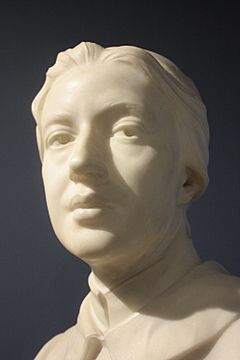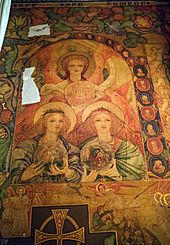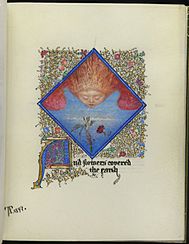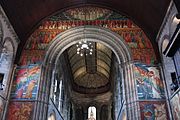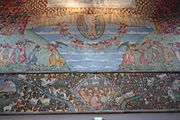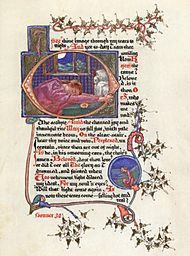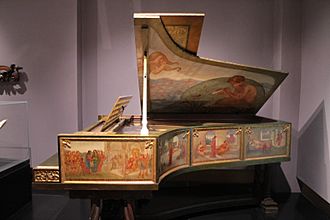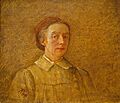Phoebe Anna Traquair facts for kids
Quick facts for kids
Phoebe Anna Traquair
|
|
|---|---|
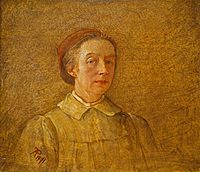
Phoebe Traquair, self-portrait, 1911
|
|
| Born |
Phoebe Anna Moss
24 May 1852 Kilternan, County Dublin, Ireland
|
| Died | 4 August 1936 (aged 84) Edinburgh, Scotland, UK
|
| Education | School of Design of the Royal Dublin Society |
| Known for | murals, embroidery, jewellery, enameling, and book illuminations |
| Spouse(s) | Ramsay Heatley Traquair |
Phoebe Anna Traquair (born May 24, 1852 – died August 4, 1936) was an amazing artist from Ireland. She became famous around the world for her part in the Arts and Crafts movement in Scotland. She was known for her illustrations, paintings, and beautiful embroidery. Her art included huge wall paintings (murals), detailed embroidery, shiny enamel jewelry, and special illuminated books. In 1920, she was honored as a member of the Royal Scottish Academy.
Contents
Phoebe Traquair's Life and Family
Phoebe Anna Moss was born on May 24, 1852, in Kilternan, County Dublin, Ireland. Her father, Dr. William Moss, was a doctor, and her mother was Teresa Moss. Phoebe was the sixth of their seven children.
She studied art at the School of Design of the Royal Dublin Society from 1869 to 1872. On June 5, 1873, she married Ramsay Heatley Traquair, a Scottish scientist who studied ancient fish fossils. In 1874, they moved to Colinton Farm in Edinburgh, Scotland. Phoebe even helped her husband by drawing detailed pictures of the fossil fish he studied. These drawings are now kept in the National Museums Scotland. Phoebe and Ramsay had three children: Ramsay, Harry, and Hilda.
Phoebe's older brother, William Richardson Moss, loved collecting art. He owned many works by the famous artist Dante Gabriel Rossetti. Phoebe also loved art, especially the works of Rossetti and William Blake. Their art and poems greatly influenced her own style and the subjects she chose to paint throughout her life.
Art at the Royal Hospital for Sick Children
Between 1885 and 1886, Phoebe Traquair created beautiful murals for the Mortuary Chapel at the Royal Hospital for Sick Children, Edinburgh. This small room was a peaceful place where children's bodies were kept before burial. Her mural, called Three Maidens, showed divine powers. Around it, she painted images of famous writers, artists, and critics like Edward Burne-Jones and John Ruskin. This was her first big art project as a professional artist.
The original building was changed in 1894. So, Phoebe carefully moved her murals to a new spot. She then restored them and added more details between 1896 and 1898.
Murals at St Mary's Cathedral
Phoebe's murals in the song school of St Mary's Cathedral (1888–92) made her famous across the country. The song school has a curved ceiling like a tunnel. On the east wall, she painted the cathedral's clergy and choir. The south wall shows artists she admired, such as Dante Gabriel Rossetti and William Holman Hunt. On the north wall, birds and choir singers are shown singing together. The west wall features four beasts singing a holy song called the Sanctus. She also made a special book with copies of the small round pictures from the mural's borders, along with her own handwritten text. The Song School is still used every day by the choir.
Mansfield Place Church Murals
Phoebe Traquair's most well-known work is in the huge former Catholic Apostolic Church (1893–1901) in Edinburgh. This building is now called the Mansfield Traquair Centre. People have called it "Edinburgh’s Sistine Chapel" because of its amazing beauty. This work truly helped her become famous all over the world.
Other Artistic Creations
Phoebe Traquair also designed the first enamel panels above the knights' seats in the Thistle Chapel of St Giles' Cathedral. Another important work is her illuminated manuscript of Sonnets from the Portuguese by the poet Elizabeth Barrett Browning. This beautiful book is kept at the National Library of Scotland.
Phoebe was a very busy artist. Besides her murals and embroidery, she made hundreds of pieces of jewelry. She was asked to show her art at the World's Fair in Chicago in 1893. Her four silk-embroidered panels, called The Progress of the Soul, were shown in St. Louis in 1904. That same year, she returned to painting murals for the chancel of St Peter's Church, Clayworth in Nottinghamshire. Her last mural was finished between 1920 and 1922 for the Manners family chapel at Thorney Hill.
Many other works by Traquair are on display at National Museums Scotland in Edinburgh. These include:
- Enamel pieces
- Illuminated books of poems
- A piano decorated with scenes from stories and the Bible
- A set of three embroideries based on the story of the Redcrosse Knight from Edmund Spenser's famous poem.
In 1897, at Kellie Castle in Fife, Phoebe Traquair painted a panel above the fireplace in the Drawing Room. This painting was inspired by Botticelli's "Primavera." It was covered up in the late 1940s but was beautifully restored in 1996 by the National Trust for Scotland.
Phoebe Traquair's Final Resting Place
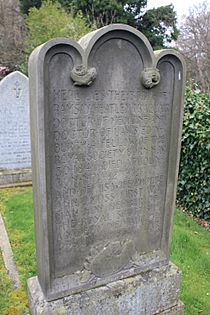
Phoebe Traquair is buried with her husband and the ashes of her son Harry Moss Traquair. Their grave is in the Colinton Parish Church graveyard in Edinburgh. Phoebe herself designed the gravestone, and it was carved by Pilkington Jackson.
Images for kids


